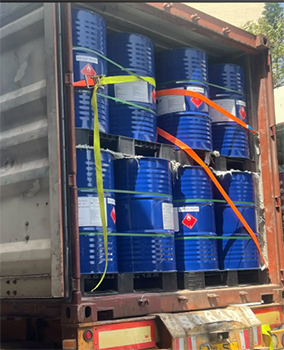Isobutanol(IUPAC name: 2-methyl-1-propanol) is a colourless, flammable organic compound with a distinctive odour. It has three isomers: n-butanol, sec-butanol, and tert-butanol. As an alcohol, it is widely used as a solvent in chemical reactions and is also a useful raw material in organic synthesis.
Molecular formula: C4H10O
Molar mass: 74.12 g/mol
Density: 0.802 g/cm³ (liquid)
Melting point: -108 °C
Boiling point: 108 °C
Solubility: 8.7 mL/100 mL (water)
Viscosity: 3.95 cP (20°C)
Flash point: 28 °C
Ignition temperature: 415 °C
Upper Explosion Limit: 10.6% (V/V)
Lower Explosion Limit: 1.7% (V/V)
Dangerous Goods Transport Number: 33552
UN Number: 1112
Hazard Class: 3
Packaging Group: O53
Transport Labels and Markings: Flammable Liquid
The primary use of isobutanol is in the production of isobutyl acetate, a compound primarily used in the manufacture of paints and similar coatings, as well as a food flavouring agent. Isobutanol is also used in the industrial synthesis of isobutyl esters, such as diisobutyl phthalate (DIBP), which serves as a plasticiser for rubber, plastics, and other materials. Other applications of isobutanol include serving as a solvent for paints, inks, and other materials, as well as a cleaning agent for varnishes. Adding a small amount of isobutanol to paint can reduce its viscosity, improve brush flow, and prevent the formation of petroleum residues on the surface of painted items. Some minor uses of isobutanol include serving as a gasoline additive for spark-ignition engines, which helps prevent carburettor icing. Isobutanol can also be used as a chemical extractant for organic compounds and as a mobile phase in thin-layer chromatography. In the future, isobutanol may replace gasoline as a fuel for internal combustion engines.
and similar coatings, as well as a food flavouring agent. Isobutanol is also used in the industrial synthesis of isobutyl esters, such as diisobutyl phthalate (DIBP), which serves as a plasticiser for rubber, plastics, and other materials. Other applications of isobutanol include serving as a solvent for paints, inks, and other materials, as well as a cleaning agent for varnishes. Adding a small amount of isobutanol to paint can reduce its viscosity, improve brush flow, and prevent the formation of petroleum residues on the surface of painted items. Some minor uses of isobutanol include serving as a gasoline additive for spark-ignition engines, which helps prevent carburettor icing. Isobutanol can also be used as a chemical extractant for organic compounds and as a mobile phase in thin-layer chromatography. In the future, isobutanol may replace gasoline as a fuel for internal combustion engines.
Isobutanol is a volatile, flammable liquid that should be stored in a well-ventilated, cool, dry location away from sources of ignition, high temperatures, and oxidisers. It can cause mild skin irritation and severe irritation to the eyes, mucous membranes, and respiratory tract. Exposure to high concentrations of vapours may cause temporary anaesthesia. Isobutanol is considered to have mild toxicity and has been shown to potentially cause liver damage in mice and humans. Ingestion of excessive amounts may also lead to alcohol poisoning.
The transportation of isobutanol must comply with relevant regulations and standards, using dedicated tank (container) trucks, small-opening steel drums, thin steel plate drums, or tin-plated thin steel plate drums (containers) and other sealed containers to prevent leakage, seepage, and damage. Transport vehicles must be equipped with appropriate types and quantities of firefighting equipment and leakage emergency response devices. Transportation is best conducted early morning or evening during summer. Tank (container) trucks used for transportation must be equipped with grounding chains, and perforated partitions may be installed inside the tank to reduce static electricity generated by vibration. Mixing with oxidisers, acids, food chemicals, etc., is strictly prohibited. During transportation, exposure to sunlight, rain, and high temperatures must be prevented. During intermediate stops, keep away from fire sources, heat sources, and high-temperature areas. Vehicles transporting this material must have flame arresters on their exhaust pipes, and the use of machinery or tools that may produce sparks is strictly prohibited during loading and unloading. During road transport, follow designated routes and avoid stopping in residential areas or densely populated areas. During rail transport, coasting is strictly prohibited. Transport in bulk using wooden or cement boats is strictly prohibited.
As a hazardous material, the maritime export of isopropyl alcohol must comply with the regulations set by the International Maritime Organisation (IMO). Packaging, labelling, documentation, and declaration procedures must adhere to the International Maritime Dangerous Goods Code (IMDG Code). Additionally, proper loading, securing, and isolation must be conducted in accordance with the vessel's safe loading guidelines. Isobutanol is classified as a flammable liquid of Class 3 with a flash point of 28 °C. Therefore, it must be transported in explosion-proof containers that meet the required standards, and fire prevention, explosion prevention, and ventilation measures must be implemented on board the vessel to avoid contact with open flames, high temperatures, and static electricity. Isobutanol is also classified as a toxic substance under Class 6.1, with a toxicity rating of T (Toxic). Therefore, it must be stored in containers with good sealing properties, and measures must be taken on board the vessel to prevent leakage and contamination, avoiding contact with water sources and food. Isobutanol also has irritating and corrosive properties, so it must be stored in containers made of corrosion-resistant materials, and measures must be taken on board the vessel to protect the health and safety of personnel, avoiding contact with skin and eyes.
Contact: Tony Li
Phone: +86-13263299644
Tel: +86-13263299644
Email: sales@ecoviaet.com
Add: No 3 Youyi Road,Tangshan,Huantai,Zibo,China
We chat
